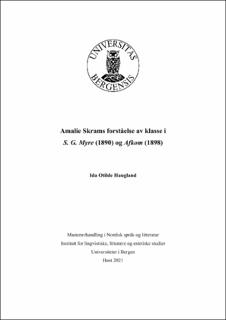Amalie Skrams forståelse av klasse i 'S. G. Myre' (1890) og 'Afkom' (1898)
Master thesis
Permanent lenke
https://hdl.handle.net/11250/2997047Utgivelsesdato
2021Metadata
Vis full innførselSamlinger
Sammendrag
This thesis is a study of Amalie Skram’s perception of class and is based on her two final novels in Hellemyrsfolket: S. G. Myre (1890) and Afkom (1898). The novels’ class theme is clear, and they are particularly interesting as the plot is situated in the transitional period between a status society (‘standssamfunn’) and a class society in Norway. Earlier research has primarily researched class in Skram’s works through selected perceptions of class linked to specific theories. Through an analysis of the novels, this thesis research Skram’s own, overall understanding of class.
The theoretical foundation of this thesis is the class theorists Karl Marx, Max Weber, Pierre Bourdieu, Beverley Skeggs, and the writer Karin Sveen. Their theories give us an understanding of today’s researchers’ and readers’ perception of class. In addition, their theories are used as a basis of comparison to Skram’s perception of class. In the novel analysis I examine the society Skram describes, with emphasis on the four main characters Sivert, Petra, Severin and Fie, and the motif of class mobility.
The thesis shows that Amalie Skram’s class perception is very complex and appears surprisingly modern. She is early in describing the emergence of class society in a way that partly anticipates later class theorists’ insights and partly different from contemporary class theorists. The thesis argues that both the novels describe a class society, where the practical social mobility is possible, though hard. I argue that Skram perceives class as a group of people with the same prerequisites to be content with the life they live. The working class experience their own class as destructive and the upper class as attractive, with room for the individual and the possibility for happiness. This perception correlates with what seems to be Skram’s literary project to understand people that are unsuccessful and how this relates to class. Skram’s perception of class combines the mechanics of class society and their impact on people, with an understanding of people’s innate differences.
